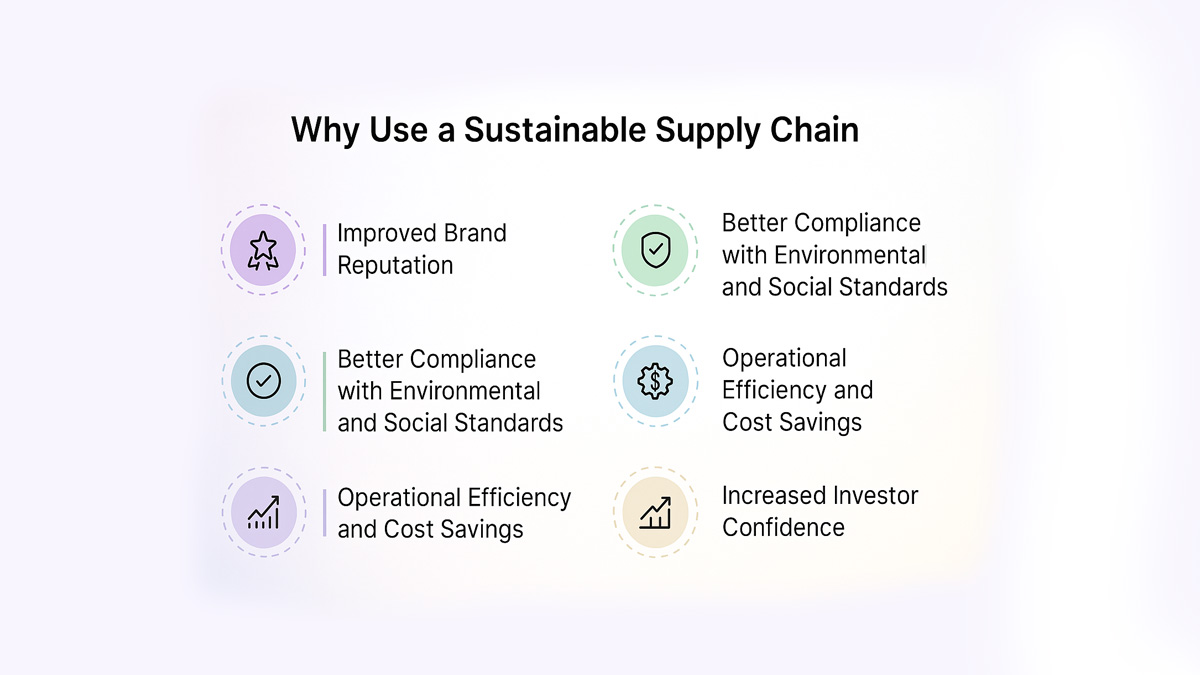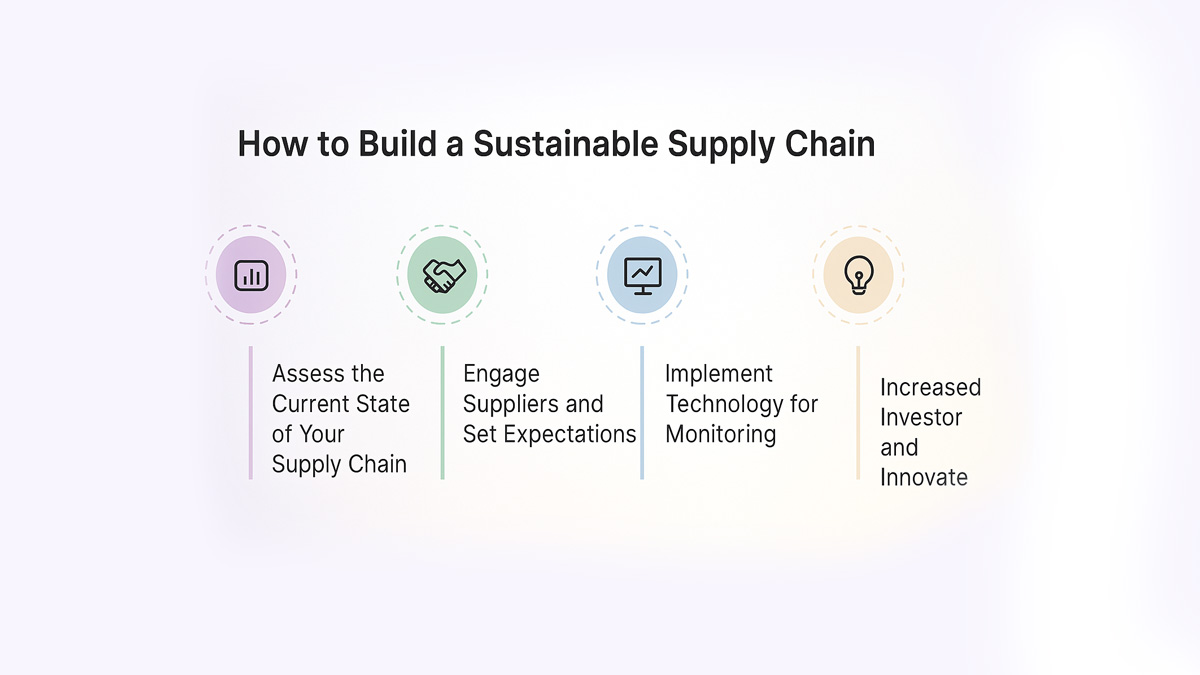

What Is Sustainable Supply Chain? A Quick Guide (+Meaning & Examples)

What Is Sustainable Supply Chain? A Quick Guide (+Meaning & Examples)
Explore supply chain sustainability - what it is, why it matters, and steps to build a responsible and resilient supply chain.


Today’s global supply chains span continents and industries - but they also carry complex challenges. As climate change, ethical concerns, and stakeholder expectations rise, companies are under increasing pressure to ensure their supply chains are both environmentally and socially responsible. This blog explains what supply chain sustainability means, why it matters, and how businesses can build responsible and resilient supply chains.
What Is Supply Chain Sustainability?
Supply chain sustainability refers to the management of environmental, social, and economic impacts across the supply chain. It involves adopting ethical, environmentally sustainable practices in procurement, production, logistics, and supplier relationships.
This includes minimizing pollution, reducing greenhouse gas emissions, preventing deforestation, and promoting fair labor practices. This also helps lower the overall carbon footprint of operations.
In short, a sustainable supply chain goes beyond profit. It ensures responsible operations at every tier - from raw material sourcing to the end customer - while protecting ecosystems and improving community health.
Why is Sustainability Important in the Supply Chain?
Sustainable supply chain practices aren’t just a trend - they are becoming a business imperative. Here's why:

1. Reduces Environmental Impact
Sustainable supply chains help reduce environmental degradation by limiting deforestation, emissions, and pollution. They promote resource efficiency, waste reduction, and water security - contributing to long-term ecosystem health.
2. Promotes Social Responsibility
By improving working conditions, eliminating forced labour, and addressing gender discrimination, companies support socially sustainable practices. Sustainable supply chain management plays a key role in enforcing these ethical standards. A responsible supply chain ensures compliance with health and safety standards, protects labor rights, and supports community well-being.
3. Meets Consumer and Investor Expectations
Customers and investors increasingly demand transparency, ethical sourcing, and sustainable innovation. Failing to meet these expectations can lead to reputational damage and lost market share.
4. Mitigates Reputational and Financial Risks
Ignoring sustainability can lead to operational, financial, and reputational risks. From non-compliance with legislation to scandals involving child labour, unethical supply chains can harm a brand’s image and bottom line.
5. Enhances Long-Term Supply Chain Resilience
Sustainable supply chains are more adaptable to global disruption and climate change. They create stronger supplier relationships, reduce dependency on finite resources, and promote long-term operational stability.
Examples of Sustainable Supply Chains
Many leading companies are setting the benchmark for what a sustainable supply chain looks like. By embedding ethical and environmentally conscious practices into their operations, they demonstrate that sustainability and profitability can go hand in hand.
- Patagonia sources raw materials from organic farms and ensures safe working conditions across its suppliers.
- Unilever has committed to zero deforestation and promotes fair wages across its global operations.
- IKEA uses sustainable forestry practices and prioritizes circular supply chains to reduce waste.
These companies lead by embedding sustainability into every decision - from procurement to packaging.
Three Tiers of the Supply Chain and Their Impact on Sustainability
To build a truly sustainable supply chain, companies must consider the impact at every tier:
Tier 1: Direct Suppliers
These are the suppliers your business works with directly. Ensuring they follow environmental standards and fair labor practices is essential. For example, requiring ESG certifications or third-party audits can improve compliance.
Tier 2: Subcontractors and Partners
These suppliers support Tier 1 operations. While less visible, they play a critical role in sustainability. Monitoring Tier 2 helps prevent unethical practices like unsafe working conditions or use of conflict minerals.
Tier 3: Raw Material and Resource Providers
At the base of the supply chain, raw material providers often pose the highest risks. Unchecked operations here can contribute to deforestation, water pollution, or forced labour. Sustainability begins at the source.
Benefits of a Sustainable Supply Chain
Investing in sustainable practices offers both short- and long-term advantages:
1. Improved Brand Reputation
A responsible supply chain builds consumer trust. Brands that demonstrate ethical and green supply chain practices attract loyal customers and positive media attention.
2. Better Compliance with Environmental and Social Standards
Meeting global and regional legislation requirements helps avoid penalties and disruptions. Examples include the EU’s Corporate Sustainability Due Diligence Directive and various anti-slavery laws.
3. Operational Efficiency and Cost Savings
Sustainability drives smarter resource use. Reducing waste, optimizing transportation, and avoiding regulatory fines can significantly lower costs. These measures also help in cutting down carbon emissions.
4. Increased Investor Confidence
More investors are prioritizing ESG (Environmental, Social, and Governance) performance. Demonstrating sustainability can attract sustainable investments and improve access to capital. Long-term goals may even include operating on a carbon-neutral basis. Many are actively backing businesses with strong sustainability initiatives.
Challenges of Supply Chain Sustainability
Despite the benefits, companies face real barriers:
1. Lack of Transparency Across Tiers
It’s difficult to monitor and verify practices across multiple countries and partners, especially in Tier 2 and 3. Solution: Companies can invest in digital traceability tools and require supplier disclosures to improve visibility across all levels.
2. Complex Global Supply Chains
International sourcing introduces risks related to inconsistent social standards, legislation, and climate-related disruptions. Solution: Standardizing supplier policies and working with regional experts can help ensure compliance and reduce exposure to global risks.
3. Unethical Labor Practices and Unsafe Conditions
Without oversight, issues like child labour, gender discrimination, or unsafe factories may go unnoticed. Solution: Regular third-party audits and strict supplier codes of conduct help enforce ethical practices on the ground.
4. High Implementation Costs
Sustainability audits, certifications, and supply chain redesigns require upfront investment. Smaller businesses may struggle to fund long-term programs. Solution: Starting with high-risk suppliers and scaling efforts gradually can make sustainability efforts more financially manageable.
Best Practices for Supply Chain Sustainability
Here are effective strategies businesses can adopt to build more ethical and sustainable supply chains:
1. Map the Full Supply Chain
Understanding your suppliers - especially beyond Tier 1 - is critical. Use tools and surveys to identify who is involved and where risks lie.
2. Establish Clear Environmental and Social Standards
Understanding your suppliers - especially beyond Tier 1 - is critical. Use tools and surveys to identify who is involved and where risks lie.
3. Use Ethical and Local Sourcing
When possible, source materials from certified sustainable providers or local vendors. This reduces emissions and improves transparency.
4. Monitor and Audit Suppliers Regularly
Conduct third-party audits and use supply chain management software to track performance. Regular checks encourage accountability and ongoing improvement.
4 Steps to Build a More Sustainable Supply Chain
These actionable steps can help any business improve its supply chain sustainability:

1. Assess the Current State of Your Supply Chain
Conduct a sustainability audit. Identify environmental hotspots, social risks, and areas for improvement across all tiers.
2. Engage Suppliers and Set Expectations
Communicate your sustainability goals. Offer training, share resources, and build long-term partnerships based on shared values.
3. Implement Technology for Monitoring
Use supply chain software with features like real-time tracking, risk analytics, and compliance alerts to streamline oversight. Integrating Internet of Things (IoT) devices can enhance monitoring precision across the chain.
4. Continuously Optimize and Innovate
Sustainability is not a one-time project. Review performance regularly and adopt innovations such as green logistics or recyclable packaging. Exploring sustainable packaging solutions can further reduce environmental impact.
Emerging Trends in Supply Chain Sustainability
Several trends are shaping the future of responsible supply chains:
1. Digital Traceability and Blockchain
These technologies improve visibility, reduce fraud, and help verify ethical sourcing claims.
2. Climate Risk Modeling and Reporting
Advanced tools now help companies predict supply chain risks from climate change and plan accordingly. Some are also transitioning to electric vehicles for greener logistics.
3. Shift Toward Circular Supply Chains
More businesses are designing processes that reuse and recycle materials - reducing waste and dependence on new resources. These efforts support the transition to a circular economy model.
4. Rise of Sustainable Procurement Policies
Governments and large organizations are mandating responsible supply chains through purchasing standards and legislation.
How Spendflo Helps Enable a Sustainable Supply Chain
Spendflo empowers organizations to gain visibility and control over their procurement and vendor ecosystem. By centralizing supplier data and spend, Spendflo helps businesses eliminate redundant tools, ensure compliance with ethical standards, and reduce costs.
It also fosters stronger alignment with supply chain partners on ESG goals. With automated workflows, contract tracking, and spend optimization features, Spendflo supports both environmental and financial sustainability across the supply chain.
Spendflo’s platform also enables supplier scorecards and benchmarks, which are crucial for tracking ESG compliance. By working with vetted vendors and maintaining full procurement visibility, companies can avoid reputational risks, improve supplier relationships, and meet both investor and regulatory expectations for responsible operations.
Book a free demo to see how you can simplify and enable a sustainable supply chain and take control of your spend today.
Frequently Asked Questions on Supply Chain Sustainability
What is an example of supply chain sustainability in action?
Unilever’s sustainable sourcing of palm oil and their zero-deforestation policy is a strong example. They ensure suppliers meet social and environmental standards, reducing deforestation and supporting community livelihoods.
How does a sustainable supply chain benefit business?
It improves brand image, reduces operational risks, ensures regulatory compliance, and attracts ESG-focused investors - all while contributing to long-term cost savings and resilience.
What challenges do companies face in going green?
Challenges include limited supplier transparency, inconsistent standards across regions, high implementation costs, and complex global networks that make sustainability difficult to enforce consistently.
Can technology improve supply chain sustainability?
Yes. Digital tools like procurement platforms, ESG tracking software, and blockchain improve visibility, streamline audits, and support real-time monitoring of supplier performance.
How often should companies evaluate their supply chain for sustainability?
Evaluations should be conducted at least annually, but ideally every quarter - especially for high-risk industries or suppliers. Ongoing tracking tools can help maintain continuous oversight.










.png)




.png)










.avif)





